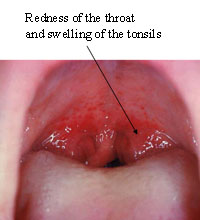35.3.1 Clinical manifestations and complications of pharyngitis
Pharingitis generally begins with the sudden onset of fever (temperature above 37.5oC, measured with a thermometer in the armpit), and a sore throat, with redness and swelling of the tonsils at the back of the throat (Figure 35.7). Other symptoms include headache, cough, runny nose and pain during swallowing.

Infection of the pharynx by Group A Streptococci has many complications, which include otitis media and throat abscesses (swelling containing pus). In a minority of severe cases, a form of heart disease – called rheumatic heart disease – can develop as a result of the body’s attempt to fight the infection. The immune system recognises Group A Streptococci as ‘foreign’ and produces antibodies that attack the bacteria. Antibodies are specialised proteins made by specific white blood cells as part of the body’s defence against infection. However, in rare cases, the antibodies produced to fight Group A Streptococci can attack the heart muscle of the infected child. As a result, these children can develop rheumatic heart disease later in life.
35.3 Pharyngitis
